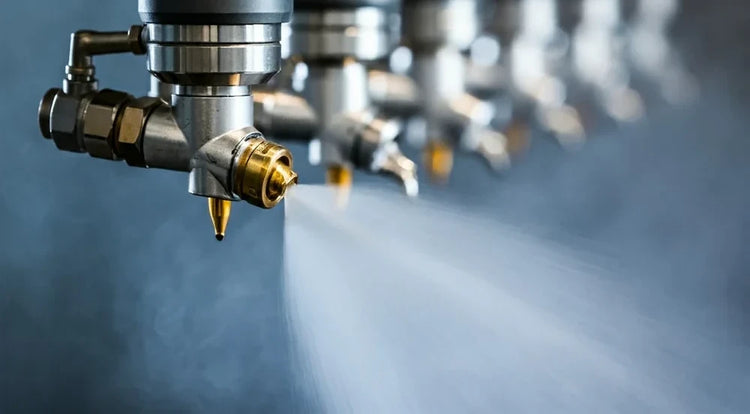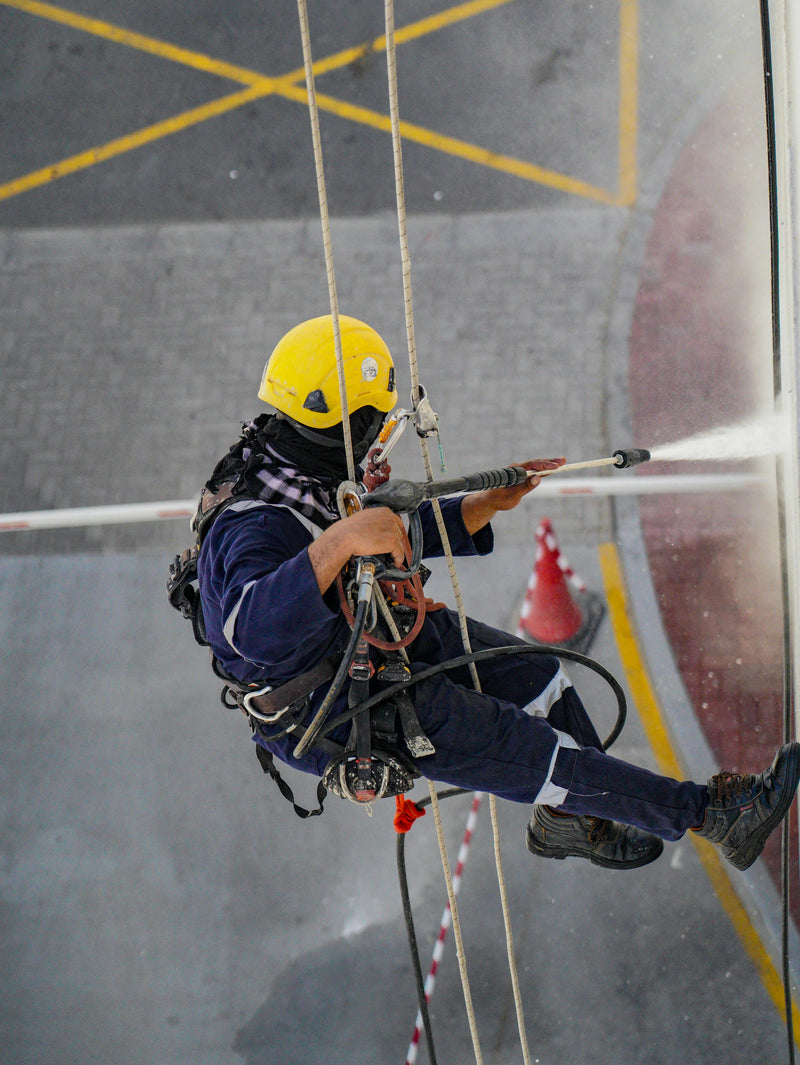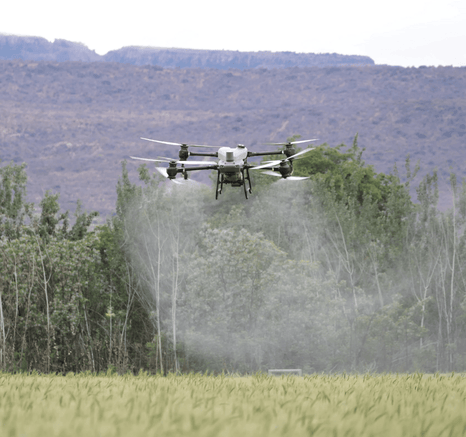So, you've got a pressure washer, right? And you're probably wondering what all those different little quick connect nozzle tips are for. It can feel a bit confusing at first, but honestly, once you get the hang of it, these quick connect nozzle attachments make a huge difference in how well your pressure washer works. This guide is all about helping you understand them better, pick the right one for the job, and keep them in good shape. Let's get into it!
Key Takeaways
- Different quick connect nozzle types have specific uses; knowing their color codes helps pick the right one.
- Picking the correct quick connect nozzle for a cleaning job means better results and safer cleaning.
- Regular cleaning and checking your quick connect nozzles helps them last longer and work better.
- If your quick connect nozzle isn't spraying right, there are simple ways to fix it or know when to get a new one.
- Using quick connect nozzles smartly makes your cleaning faster and more effective.
Understanding Quick Connect Nozzle Types
The Purpose of Color Coding
Ever wonder why your pressure washer nozzles are different colors? It's not just for looks! The color coding is a simple way to instantly identify the spray pattern and intensity of each nozzle. This helps prevent accidental damage to surfaces by using a nozzle that's too powerful. Think of it as a visual guide to pressure washing. For example, you wouldn't want to use the same nozzle on your car as you would on a concrete driveway. The color tells you at a glance what the nozzle is designed for. It's a pretty smart system, really.
0-Degree Nozzle: The Powerhouse
The 0-degree nozzle, often red, is the most intense nozzle in your arsenal. It delivers a concentrated, pinpoint stream of water. This makes it ideal for blasting away stubborn grime, like dried paint or caked-on mud. However, it's also the most likely to cause damage if used improperly. You should use it with caution and only on surfaces that can withstand the extreme pressure. It's not something you'd want to use on your car or siding. Think of it as the heavy artillery of pressure washing – powerful, but requiring careful handling. Here's a quick guide:
- Extremely powerful, concentrated stream
- Best for removing tough, stuck-on materials
- High risk of surface damage
Specialty Nozzles for Specific Tasks
Beyond the standard set, there's a whole world of specialty nozzles designed for specific cleaning jobs. These can significantly improve your pressure washing efficiency and results. For example, there are turbo nozzles that combine the power of a 0-degree nozzle with a wider spray pattern, or soap application nozzles that gently apply detergents. There are even nozzles designed for cleaning gutters or unclogging drains. Investing in a few of these specialty nozzles can really expand the capabilities of your pressure washer. Here are some examples:
- Soap Nozzles (usually black): Designed for applying detergents and cleaning solutions at low pressure.
- 40-Degree Nozzles (often white): Produce a wider, gentler spray for delicate surfaces like windows and painted areas.
- Surface Cleaner Attachments: These use multiple nozzles within a housing to clean large, flat surfaces quickly and evenly.
Using the right nozzle for the job is not just about getting the best clean; it's also about protecting the surfaces you're cleaning and ensuring your safety. Always take a moment to consider the task at hand and choose the appropriate nozzle accordingly.
Selecting the Right Quick Connect Nozzle
Choosing the correct quick connect nozzle is super important for getting the best results from your pressure washer. It's not just about blasting away dirt; it's about doing it efficiently and without damaging surfaces. Think of it like choosing the right tool for any job – the right nozzle makes all the difference.
Matching Nozzle to Cleaning Task
Different jobs need different nozzles. A 0-degree nozzle is great for blasting away tough stains, but it's overkill for washing your car. For general cleaning, like patios or sidewalks, a wider spray pattern is usually better. Here's a quick guide:
- 0-degree (Red): Intense, concentrated power. Use for removing stubborn stains on concrete or metal. Be careful – it can damage softer surfaces.
- 15-degree (Yellow): A good balance of power and coverage. Great for stripping paint or cleaning brick.
- 25-degree (Green): All-purpose nozzle for general cleaning tasks like decks and driveways.
- 40-degree (White): Wider, gentler spray. Ideal for washing cars, boats, and other delicate surfaces.
- Soap Nozzle (Black): Low-pressure nozzle for applying soap and detergents.
Considering Surface Sensitivity
Not all surfaces are created equal. Blasting a wooden deck with a 0-degree nozzle is a recipe for disaster. Always consider how delicate the surface is before choosing a nozzle. A wider spray pattern distributes the pressure over a larger area, reducing the risk of damage. For sensitive surfaces, start with a 40-degree nozzle and test a small, inconspicuous area first. You can always increase the pressure or switch to a more focused nozzle if needed, but it's better to start gentle and work your way up.
Optimizing Pressure and Spray Pattern
Getting the right pressure and spray pattern is key to efficient cleaning. Too much pressure, and you risk damaging the surface. Too little, and you won't get anything clean. The goal is to find the sweet spot where you're removing dirt and grime without causing harm. Experiment with different nozzles and pressures to see what works best for each task. Also, remember that the distance you hold the wand from the surface affects the pressure. The closer you are, the more intense the pressure.
It's a good idea to keep a variety of nozzles on hand so you can quickly switch between them as needed. This will not only make your cleaning tasks easier but also help you avoid costly mistakes. Think of it as having a well-stocked toolbox – you'll be prepared for anything.
Here's a table showing the relationship between nozzle angle and spray width at a fixed distance:
|
Nozzle Angle |
Spray Width at 1 Foot |
Spray Width at 3 Feet |
|
0 degrees |
Concentrated Point |
Concentrated Point |
|
15 degrees |
~3 inches |
~9 inches |
|
25 degrees |
~5 inches |
~15 inches |
|
40 degrees |
~8 inches |
~24 inches |
Essential Quick Connect Nozzle Maintenance
Like any tool, your pressure washer's quick connect nozzles need some TLC to keep them working their best. Neglecting maintenance can lead to poor performance, or even damage your equipment. Let's walk through the simple steps you can take to keep your nozzles in tip-top shape.
Regular Cleaning Practices
Nozzles are prone to clogs. Debris and mineral buildup can restrict water flow and mess with your spray pattern. Here's how to keep them clean:
- Flush after each use: Run clean water through the nozzle after every job to remove loose particles.
- Soak in vinegar: For stubborn clogs, soak the nozzle in white vinegar for a few hours. The vinegar helps dissolve mineral deposits.
- Use a nozzle cleaning tool: A small wire or nozzle cleaning tool (often included with your pressure washer) can dislodge debris from the nozzle orifice. Always be gentle to avoid damaging the nozzle.
Inspecting for Wear and Damage
Regular inspection is key to spotting problems before they become major headaches. Look for these signs of wear:
- Cracks or chips: Even small cracks can affect the spray pattern and reduce pressure.
- Deformation: Check if the nozzle opening is still perfectly round. An oval or otherwise misshapen opening indicates wear.
- Corrosion: If you see rust or corrosion, it's time to replace the nozzle. A corroded nozzle can contaminate your cleaning solution and damage surfaces.
Proper Storage Techniques
How you store your nozzles can significantly impact their lifespan. Here are some tips:
- Store in a dry place: Moisture can lead to corrosion and buildup.
- Protect from sunlight: UV exposure can degrade plastic nozzles over time.
- Use a storage case: A dedicated case or organizer keeps your nozzles clean, protected, and easy to find. I use a small toolbox with dividers, and it works great.
Taking a few minutes to properly maintain your quick connect nozzles will save you time, money, and frustration in the long run. Plus, you'll get better cleaning results!
Troubleshooting Common Quick Connect Nozzle Issues
Addressing Clogs and Blockages
Okay, so you're out there, ready to blast away some grime, and suddenly... nothing. Or worse, a weak, sputtering spray. Chances are, you've got a clog. This is probably the most common issue with pressure washer nozzles. Debris like dirt, sand, or mineral deposits can build up inside the nozzle, messing with the water flow.
Here's what we suggest:
- First, turn off the pressure washer and disconnect the nozzle. Safety first!
- Grab a nozzle cleaning tool (those little wires are super handy) or even just a small pin or paperclip. Gently poke around in the nozzle opening to dislodge any visible gunk.
- If that doesn't work, try soaking the nozzle in warm water with a bit of vinegar. Let it sit for a while to dissolve any stubborn deposits. Sometimes I let it sit overnight.
- After soaking, rinse the nozzle thoroughly with clean water to make sure you've got everything out.
If you're dealing with really tough clogs, you might need to use a specialized nozzle cleaner. Just be sure to follow the instructions carefully and wear gloves to protect your skin.
Resolving Uneven Spray Patterns
An uneven spray pattern is another annoying problem. Instead of a nice, even fan of water, you might get streaks, spots, or just a generally wonky spray. This usually means something is partially blocking the nozzle or that the nozzle itself is damaged.
Here's a quick checklist:
- Check for clogs, even if you think you already cleared them. Sometimes, a tiny piece of debris can still be causing problems.
- Inspect the nozzle tip for any visible damage, like cracks, chips, or wear. Even small imperfections can throw off the spray pattern.
- Make sure the nozzle is properly seated and connected to the wand. A loose connection can cause an uneven spray.
If you've checked all of those things and the spray pattern is still uneven, it might be time to consider replacing the nozzle.
When to Consider Nozzle Replacement
Nozzles don't last forever. Over time, they can wear out, become damaged, or simply lose their effectiveness. Knowing when to replace a nozzle can save you a lot of frustration and ensure you're getting the best possible cleaning performance.
Here are some signs that it's time for a new nozzle:
- Visible damage: Cracks, chips, or significant wear on the nozzle tip.
- Consistently uneven spray pattern: Even after cleaning, the spray is still streaky or spotty.
- Reduced pressure: The pressure washer seems less powerful than it used to be, even with the same settings.
- Nozzle is old: If you've been using the same nozzle for a long time, it might just be worn out from normal use.
|
Issue |
Possible Cause |
Solution |
|
Clogged Nozzle |
Debris, mineral deposits |
Clean with nozzle tool, soak in vinegar, rinse thoroughly |
|
Uneven Spray Pattern |
Partial blockage, damaged nozzle tip |
Check for clogs, inspect for damage, replace if necessary |
|
Reduced Pressure |
Worn nozzle, leaks |
Inspect nozzle, check connections, replace nozzle if worn |
Don't wait until your nozzle is completely useless to replace it. A new nozzle is a relatively inexpensive investment that can make a big difference in your pressure washing results. Plus, it's always good to have a spare on hand just in case!
Maximizing Efficiency with Quick Connect Nozzles
Techniques for Effective Cleaning
To really get the most out of your pressure washer, it's not just about blasting away. It's about technique. Start with the right distance from the surface. Too close, and you risk damage; too far, and you're just wasting water and time. Use overlapping strokes for even cleaning, and work from top to bottom to prevent dirty water from running over already cleaned areas. For stubborn stains, let the detergent dwell for a few minutes before rinsing. Also, consider the angle of your spray – a slight angle can sometimes be more effective than a direct hit. Don't forget to check out NozzlePro's catalog for the latest in nozzle technology.
Utilizing Nozzle Accessories
Think of your quick connect nozzles as the foundation, and accessories as the tools that let you specialize. Surface cleaners are great for large, flat areas like driveways and patios, preventing streaking and saving time. Extension wands help you reach high or awkward spots without needing a ladder. Rotary nozzles, also known as turbo nozzles, deliver a powerful, swirling spray that's excellent for breaking down tough grime. Here's a quick rundown of some popular accessories:
- Surface Cleaners: For even cleaning of large, flat surfaces.
- Extension Wands: To reach high or difficult areas safely.
- Rotary/Turbo Nozzles: For concentrated, powerful cleaning.
- Foam Cannons: For applying detergent evenly and effectively.
Achieving Optimal Cleaning Results
Getting the best results from your pressure washer isn't just about power; it's about precision and understanding. It's about matching the right nozzle, pressure, and technique to the task at hand. Experiment with different nozzles and distances to find the sweet spot for each surface. Regular maintenance, like cleaning your nozzles and checking for wear, is also key to consistent performance. And remember, safety first! Always wear appropriate protective gear and be mindful of your surroundings. If you're unsure about something, it's always best to err on the side of caution. Here are some tips to keep in mind:
- Match the nozzle to the surface and task.
- Maintain your equipment regularly.
- Prioritize safety with protective gear.
Using the right quick connect nozzle can significantly improve your cleaning efficiency and the quality of your results. By understanding the different nozzle types, utilizing accessories, and practicing proper techniques, you can tackle any cleaning job with confidence. Remember to always prioritize safety and maintain your equipment for optimal performance.
Safety Guidelines for Quick Connect Nozzle Use
Pressure washers are great tools, but they can be dangerous if you don't use them right. It's super important to follow safety guidelines to protect yourself and your property when you're using quick connect nozzles. Let's go over some key points.
Prioritizing Personal Protection
First things first: protect yourself! Always wear safety glasses or goggles to keep debris and water from getting in your eyes. It's also a good idea to wear gloves to protect your hands from the high-pressure spray. Closed-toe shoes are a must to prevent foot injuries. Depending on the job, you might even want to consider hearing protection, especially if you're using the pressure washer for an extended period. Think about it – that motor can get pretty loud!
Avoiding Property Damage
Different surfaces require different levels of pressure. A 0-degree nozzle on wood siding? Probably not a good idea. Start with a wider spray pattern (like a 25-degree or 40-degree nozzle) and test it in an inconspicuous area first. Keep a safe distance from the surface you're cleaning to avoid damage. Be extra careful around windows, painted surfaces, and anything that could be easily damaged by high pressure. It's better to take your time and use the right nozzle than to end up with a costly repair.
Understanding Pressure Washer Limitations
Pressure washers aren't magic wands. They have limitations. Don't try to use them for tasks they're not designed for, like cleaning electrical equipment or anything that could be hazardous. Always read the manufacturer's instructions for your pressure washer and your quick connect nozzles. Know the pressure limits of your equipment and don't exceed them. If a job seems too difficult or risky, it's best to call in a professional. Safety first, always!
It's easy to get caught up in the task and forget about safety, but taking a few extra precautions can prevent accidents and injuries. Always be aware of your surroundings and use common sense when operating a pressure washer.
Upgrading Your Pressure Washing Setup
Ready to take your pressure washing game to the next level? It's not just about the machine itself; it's about optimizing every aspect of your setup for peak performance and versatility. Let's explore some ways to enhance your pressure washing experience.
Exploring Advanced Quick Connect Nozzles
Beyond the standard set of nozzles, there's a whole world of specialized options designed for specific tasks. Consider investing in nozzles with adjustable spray patterns, allowing you to switch between a wide fan and a concentrated stream on the fly. Variable nozzles can really improve your workflow. Some advanced nozzles even feature rotating jets for tackling stubborn grime or surface cleaners for large areas. Experimenting with different nozzle types can significantly improve your cleaning efficiency and results.
Finding the Perfect Nozzle for Your Needs
Ultimately, the best way to upgrade your setup is to find the perfect nozzle for the tasks you perform most often. Do you frequently clean delicate surfaces? Invest in a low-pressure nozzle specifically designed for that purpose. Are you constantly battling tough stains on concrete? A turbo nozzle might be just what you need. Consider your specific needs and research different nozzle options to find the best fit. It might take some trial and error, but the results will be worth it. Remember to select the appropriate nozzle for the surface you're cleaning.
Upgrading your pressure washing setup is an investment in efficiency and versatility. By exploring advanced nozzles, integrating complementary accessories, and finding the perfect nozzle for your needs, you can unlock the full potential of your pressure washer and achieve optimal cleaning results.
Conclusion
So, there you have it. Getting good with your pressure washer nozzles is a big deal for getting things really clean. Knowing about the different kinds of nozzles and picking the right one for each job is super important. This little part, the nozzle, actually does a lot to make your cleaning powerful and keep your stuff safe. If you use the tips we talked about, you'll know just what nozzle to grab for any cleaning job. Go ahead, get your pressure washer ready, pick the right nozzle, and you'll be able to clean up those messes way easier than before.












